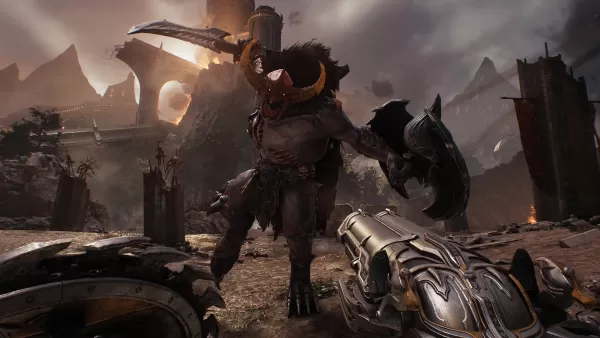When director Hugo Martin described the guiding philosophy behind *Doom: The Dark Ages* as “stand and fight” during this year’s Xbox Developer Direct, I was immediately intrigued. It’s a concept that directly contrasts with the approach taken in id Software’s previous title, *Doom Eternal*, a fast-paced shooter built around constant motion and high-energy combat. Yet, there was one enemy in *Eternal* that demanded you stop running and face it head-on—the Marauder. One of the most polarizing foes in any *Doom* game, it's despised by many… but personally, I’ve always adored it.
The moment I realized that *Doom: The Dark Ages* hinges on reacting to bright green visual cues—just like when taking down a Marauder—I knew I was fully on board. This isn’t just a callback; it’s a full evolution of the mechanic.
Don’t worry—you won’t be locked in an endless duel with anything quite as slippery as the Marauder from *Eternal*. Although *The Dark Ages* does feature the Agaddon Hunter, a shielded enemy with a devastating combo attack, the real legacy of *Eternal’s* infamous encounters isn't found in a single foe—it's embedded into every enemy encounter. The core ideas behind the Marauder have been reimagined and woven into the very fabric of *The Dark Ages’* combat design. As a result, each battle feels intelligent, dynamic, and engaging—without the frustrations once tied to facing the Marauder.
The Marauder is unique within *Doom Eternal*. Most fights involve darting around an arena, slicing through waves of lesser demons before weaving between heavier threats. In fact, *Eternal* has often been likened to a resource management game—not just for ammo and health, but also for positioning and pacing. But all of that changes the moment the Marauder appears. This axe-wielding powerhouse forces you to shift gears entirely. Unlike other enemies, he can’t be danced around or kited—he demands your full attention. That’s why he usually appears alone. Even when he doesn’t, the best strategy is to clear out weaker enemies first, then stand your ground and focus solely on him.

Of course, standing still doesn’t mean literally planting your feet. Rather, it’s about controlling space with precision. Get too close and you risk eating a point-blank shotgun blast that’s nearly impossible to dodge. Stay too far back and you’ll be bombarded with projectiles you can avoid—but at the cost of being out of range for your own counterattacks. The key is to stay in the sweet spot where the Marauder will attempt an axe strike, which is the only time he becomes vulnerable. His energy shield blocks all incoming fire until that moment. When his eyes flash bright green, it’s your signal—a fleeting chance to unload everything you’ve got.
That same green flash plays a central role in *Doom: The Dark Ages*. A tribute to the original *Doom*, demons now unleash volleys of bullet-hell-style projectiles. Among them are special green missiles that can be parried using the Doom Slayer’s new shield, sending them flying back at their source. Early in the game, this serves mostly as a defensive maneuver. But later, after unlocking the shield’s rune system, parrying becomes a powerful offensive tool, capable of stunning enemies with lightning strikes or activating your shoulder-mounted auto-targeting cannon.
As you traverse the war-torn battlefields of *The Dark Ages*, your combat evolves into a series of intense, one-on-one duels with a variety of demonic foes. Unlike the Marauder, survival here isn’t solely dependent on timing parries. Smart use of traditional tools can still carry you through. However, shield runes elevate parrying into one of the most effective elements of your arsenal—one worth using as often as possible.
Integrating parry mechanics into your combat flow reveals a shared DNA between *The Dark Ages* and *Eternal’s* Marauder battles. You must find optimal distance, since demons won’t fire projectiles up close. And when those green orbs appear, positioning becomes crucial. Just like catching the Marauder mid-swing, you need quick reflexes to execute a successful parry. All of this requires focus, transforming your battlefield into a sequence of tight, individual showdowns. You stand. You fight. Just like you did against the Marauder.
One of the biggest criticisms of the Marauder was how it disrupted the flow of *Doom Eternal*. You couldn’t rely on the same fluid tactics used elsewhere in the game. For many, that break in rhythm was infuriating. But for me, that’s exactly what made the Marauder so compelling. While *Eternal* asked you to dance, the Marauder forced you to pivot, spin, and break free from expectations. It challenged you to think differently—to break the rules of a game already breaking the mold.

*Doom: The Dark Ages* solves this issue by making varied combat styles part of the overall rhythm of the game. Each major enemy type features its own distinct green projectile or melee move, meaning your tactics must adapt with every new threat. The Mancubus, for example, fires staggered bursts of wide energy beams ending in deflectable green pillars, requiring precise left-right movement. The Vagary launches abacus-like volleys of deadly spheres, forcing you to sprint toward the rows you can reflect. Meanwhile, the skeletal Revenant channels the Marauder closely—its invulnerability drops only when you deflect one of the green skulls fired from its shoulder launchers.
Because each demon demands a different kind of movement and reaction, no encounter ever feels jarring or out of place. True, the Agaddon Hunter and Komodo present steeper challenges due to their aggressive melee combos—but by the time they arrive, you’re already accustomed to constantly adapting your tactics. That wasn’t the case in *Eternal*, where the Marauder felt like an abrupt change to a ruleset based on weapon selection rather than positional awareness and reaction-based play.
Ultimately, the Marauder’s flaw wasn’t in its design—it was in how unexpected it was. *Doom: The Dark Ages* prepares you for similar moments by making reaction-based mechanics a consistent pillar of the entire experience rather than an isolated twist halfway through. This shift does make things slightly easier—the parry window in *The Dark Ages* is more forgiving than the split-second timing required to counter the Marauder’s eye flash, even on higher difficulties. Still, the spirit of the Marauder lives on: the idea of locking in with an enemy, waiting for the perfect opening, and striking the moment that green light shines.
While *Doom: The Dark Ages* presents these concepts in a fresh way, they remain unmistakably rooted in the legacy of *Doom Eternal’s* most divisive foe. You don’t just fight—you stand and fight.






